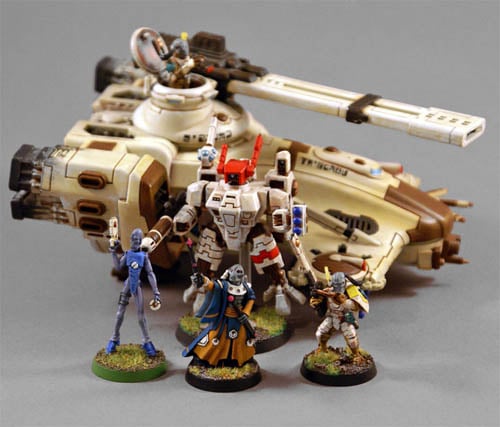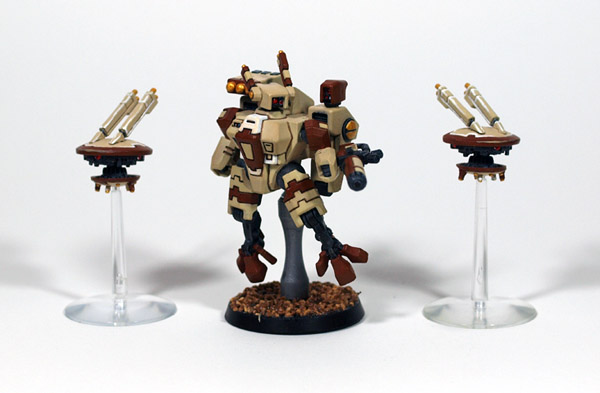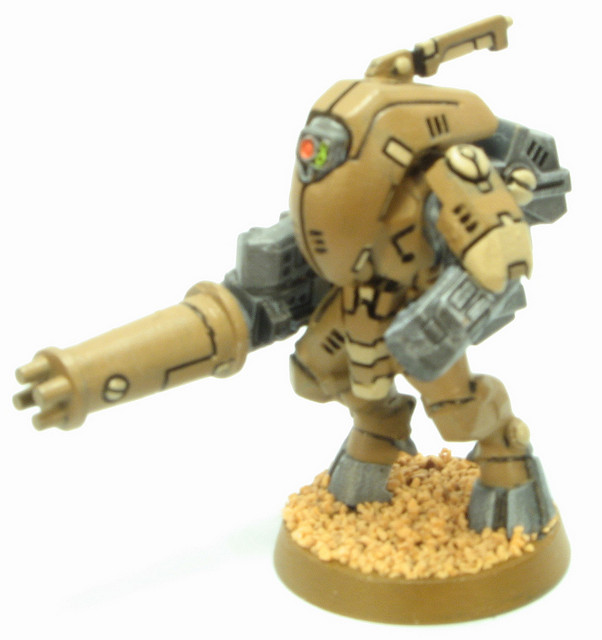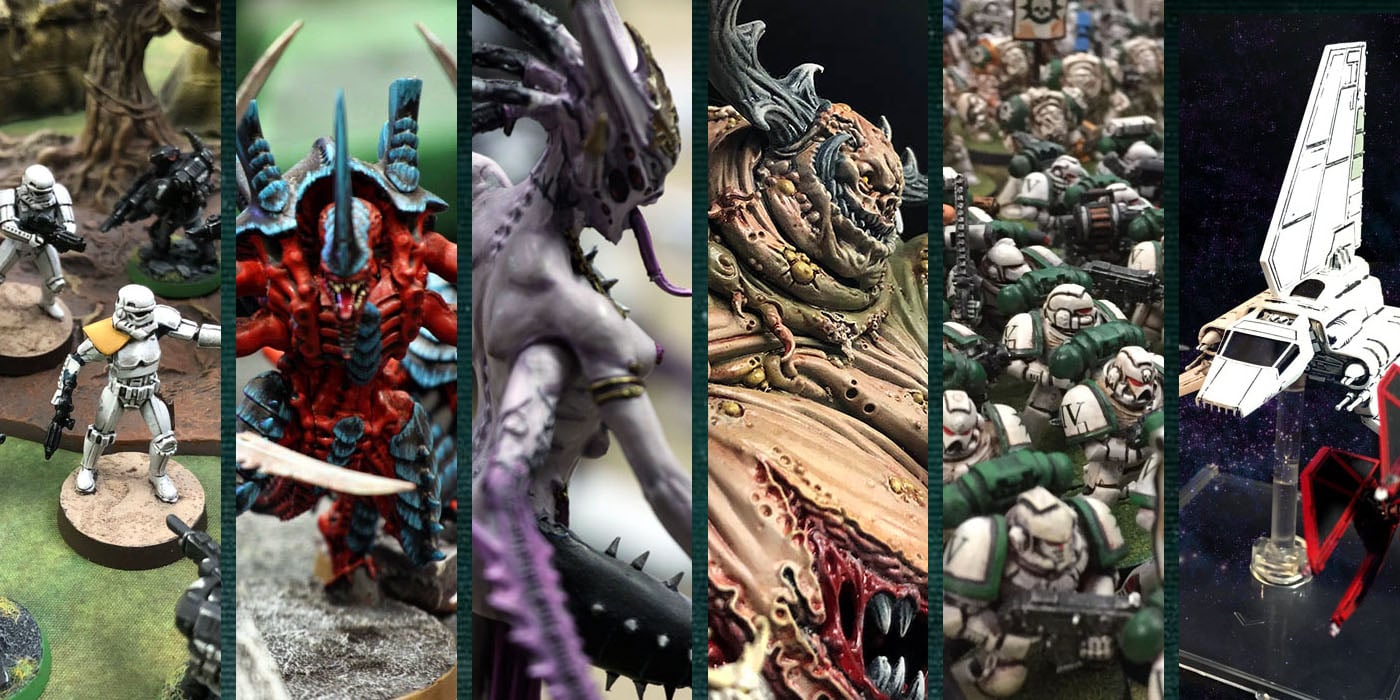40K TACTICS: Tau Elites – Crisis & Stealth Suits

Hey guys, I am Learn2Eel I’m here to talk in detail about our new Codex: Tau Empire. Lets hit it!
ELITES: Crisis & Stealth Suits
Our Elites share some of the most tactically adaptable units on a game-by-game basis, with a diversity of roles filled by each unit regardless of their equipment; two favour hit and run tactics, with one in particular gunning for Infantry, whilst the third is very much a fire magnet that can blast apart enemies from across the map. All three are strong choices in their own right, and one in particular – Crisis Teams – will have a specific kind of unit for them to hunt from game to game; they are your finely edged knife, owing to the fact that they are very specialised in terms of killing power, and as such you should take them to deal with threats the rest of your forces would typically struggle with. Given that Tau have lost out on a notable method of dealing with well armoured vehicles – Land Raiders and Monoliths come to mind – from a distance, and owing to the much welcomed range boost to Fusion Blasters, Crisis Teams are a perfect deposit for these weapons.
Conversely, Stealth Suits will always carry anti-infantry weapons in the form of the Burst Cannon, albeit with the option for one in every three to have a Fusion Blaster; this diversifies their role, but unless you are firing at elite infantry, you need target locks for the Fusion Blasters so as to not compromise one weapon or the other. The Riptide is an altogether different beast that revolves around denying deep strike play, shattering Infantry formations, wrecking light vehicles and soaking up firepower the rest of the army definitely couldn’t; it is perhaps the single most versatile unit in the codex, able to deal with almost any threat provided you equip it with the Ion Accelerator. All in all, you really can’t go wrong here, but be sure not to spend more points than absolutely necessary on these units; with Tau, more numbers are typically better, especially given any old missile launcher can ruin the day of Crisis Suits. I would also preface my individual unit tactics by saying that you really should be taking Elites for what you need most after jotting down the rest of your army list; just the way it should be.
XV8 Crisis Team – As arguably the most popular and iconic unit amongst the ranks of the Tau Empire, Crisis Teams are renowned for their incredible versatility in terms of how you can equip them to deal with any situation, as well as their innately strong harassment abilities that make them a frustrating proposition for any foe. As Jetpack Infantry with two wounds each, a Toughness of four and a +3 armour save, they are quite hardy and mobile; the Jetpack type allows them to ‘jump’ over intervening models and terrain in tight situations, with the risk of dangerous terrain, but its primary attribute for Crisis Teams to abuse is the ‘assault move’, a free 2D6 inch move in the Assault Phase if the unit doesn’t declare a charge. Given the powerful and quantifiable ranged weapons a Crisis Team can field, they are a deadly and tough – against small arms fire, at least – harassment unit that pioneered the famous “Jump Shoot Jump” tactic; that of moving out of cover and firing at enemy units, wreaking devastation in abundance, and then jumping back out of range or out of sight so that enemies can’t hurt you in return. Though this tactic’s effectiveness can be dependent on the size, structure and quantity of cover available, as well as the range of the weapons they carry, it is still an impressive trait that keeps Crisis Teams alive and dealing consistent damage – much akin to shadowed spectres that strike without warning and flee before any retaliation is organised. Think of them in this way, and that they are quite cheap for what they do; they will be a very nasty unit if used intelligently.
Given that Crisis Teams also come standard with equipment that allows each model to fire two weapons in the same shooting phase and grant them Night Vision, they can load up on enough high powered weaponry that would give Devastator-equivalent units a run for their money and completely ignore one of the more prominent defences in the early or late game against ranged attacks; of course, unlike Devastator-equivalent units, Crisis Teams are restricted mostly to medium or short-range weaponry, making full use of their risky, but effective, Jetpack type and ‘Jump Shoot Jump’ tactics.
The unit is not without downsides though, and these deficiencies must be carefully considered when equipping the Crisis Team for battle; understanding the effect on deployment, placement and target priority is also key. Though two wounds with a +3 armour save and the Toughness of a Space Marine makes them quite resilient, they are both lacking in numbers and immunity to Instant Death; with a maximum unit size of three Crisis Suits – excluding any applicable Drones – they can be rather easily gunned down through sheer weight of firepower, whilst missile launchers and other Strength eight weapons that are still common in 6th Edition can put any single member down without a fight. Power fists and monstrous creatures are also a scary proposition, but unless they are as fast – or faster – than your Crisis Team, you should be avoiding combat anyway; another consideration is that Crisis Suits are almost as terrible in a melee as Fire Warriors.
Though they are decently tough, their less than impressive Weapon Skill and Initiative of two means most enemies will both hit easier and strike before the Crisis Suits; despite this, they do have a high Strength of five and two attacks each – three for the Shas’vre – meaning they can feasibly harass light vehicles and small, isolated units, though Crisis Teams should really never be put in such a situation unless they can’t avoid it. When one acknowledges these issues, key threats need to be quickly identified during deployment; does the enemy have battle cannons, missile launchers, or other high Strength and low AP weapons in abundance (or not), and if so, how can you set up to avoid them or, otherwise, make your other less important or more durable units more threatening targets to the opponent? Similarly, fast and deadly melee attackers such as Maulerfiends, Dreadknights and the like should be given as much room as possible; this is also where the weaponry of the Crisis Team becomes very important, as a team loaded with anti-armour or anti-monstrous creature weaponry can attempt to abuse their maximum ranges as much as possible to slow these units down, or risk a closer ranged assault to annihilate them in one volley. Such tactics should come down to a purely game-by-game basis; there is no single right way to handle these threats in any given situation, as the constantly shifting balance of a game as well as the unknowable depths of an opponent’s army list makes pregame planning almost impossible. It should also be noted that the Ballistic Skill of the unit is mediocre despite their elite stature and role; they tend to put out enough shots that this isn’t too much of an issue, but any of their weapons can be twin-linked for a minimal cost at the expense of a valuable hard-point.
As to their actual options, this is really dependent on what you need your Crisis Team to field. No other unit in the Tau codex can be so specialised to a given role at your whim; if you need a unit to provide massed high Strength shots to whittle down light Infantry or even medium Infantry formations whilst your less mobile Fire Warriors move into position, Burst Cannons, Flamers and the like can prove invaluable, particularly when combined with deep striking. If your list has a deficiency when faced with Terminators and other elite Infantry, consider twin-linked plasma rifles combined with Fusion Blasters or Burst Cannons to drown them in both armour-ignoring and armour-providing wounds. If heavy vehicles are your bane and you lack the tools to destroy them reliably elsewhere, consider the risky move of equipping your Crisis Teams with twin-linked Fusion Blasters and missile pods; a potentially costly choice, but one that lends itself well to annihilating tanks and skimmers alike with aplomb. The system of choosing weaponry and supporting wargear is designed to give you total freedom in determining what enemies your army finds itself wanting against; Crisis Teams are unique in that they can be equipped to deal with any threat at a medium or short range, and do it better than almost any other unit in the codex for the cost whilst not making themselves too much of a target owing to their mobility and small unit sizes. Given that you can select up to three options from the weapon and support systems total, you are – rightfully – disallowed from going too far with the Crisis Teams, which would defeat the purpose of their low cost and high returns; given that the previously ‘must-include’ multi-tracker is now included into the (lower) base cost of the Crisis Suits, as well as not having to fill all three ‘hard-points’, you can really tailor them to how you need whilst keeping their cost as minimal as possible.
I find that the support systems, whilst useful and cheap, aren’t as necessary on Crisis Teams as they were before; multi-trackers were the most popular choice previously because it effectively doubled the fire output of each Crisis Suit, but given they are now integrated for free, many will find their old load-outs are cheaper and more effective than before with the potential for more upgrades. Some popular and inexpensive choices are the Advanced Targeting System and Target Locks; the first allows the entire unit to make Precision Shots as if they were characters which, given the weaponry they can field, is a very handy tool for neutering enemy units, whilst the second allows members of the unit to fire at different targets in what amounts to a less restrictive – but paid for – form of the Split Fire special rule. Like all other Battlesuits, Crisis Suits also have access to the effective, but expensive, Skyfire upgrade that allows them to choose to have the Skyfire special rule on their weapons on a turn-by-turn basis; given the availability of Skyfire throughout the codex, this will likely be unnecessary and jacks the price of the unit up considerably, but it is yet more proof that Tau are easily the best equipped hard-back codex to deal with fliers so far.
Discussing the weaponry in detail would probably require an entirely separate article reviewing the many different ‘builds’ or load-outs that Crisis Teams can potentially take; in that sense, I will keep this as brief and to-the-point as possible. For anti-tank purposes, the fusion blaster and missile pod are the favourites; the former for busting high-armoured vehicles, such as Land Raiders, at short range, whereas the missile pod is preferred against light vehicles owing to its higher rate of fire and far superior range. When dealing with elite Infantry or monstrous creatures, the plasma rifle is the best bet, whether twin-linked or no, and probably in conjunction with a fusion blaster or missile pod; this keeps the unit diverse, but still deadly against such units. For medium or light Infantry, burst cannons and flamers are ever popular choices; the former for its high Strength and incredible rate of fire, the latter for its effectiveness against lightly armoured foes and ‘automatic-hit’ nature, disregarding the mediocre Ballistic Skill of Crisis Suits.
Any single Crisis Suit in each detachment may also take one of the two ‘experimental’ weapons; the airbursting fragmentation projector, and the cyclic ion blaster. The former is a large blast weapon with a Strength and AP designed mostly to reave light Infantry with its Ignores Cover and Barrage special rules, though that last one is particularly useful for ‘sniping’ out enemy characters or special and heavy weapons within a unit. The latter is essentially a missile pod with half the range and an extra shot, with the added bonus that it can be over-charged and, after a Gets Hot roll, fire a Strength eight AP four small blast, making it incredibly deadly against tightly packed Infantry formations or Toughness four multi-wound units. Both are decent additions and cost as much as the majority of other weapons on hand, and as such, their use – whilst perhaps not optimal given that you can’t take multiples of them unless you are playing a game with two primary detachments – is a fun and cool addition that you should consider. It must be noted that any of the weapon options – barring the experimental pair – can be twin-linked for a measly cost at the expense of a hard-point; given that multi-trackers are standard now and that support systems aren’t as necessary as they were, this is a good and cheap option to use depending on the weapon. I feel twin-linking plasma rifles, missile pods and fusion blasters above the other weapons – particularly fusion blasters, owing to their ‘one-shot’ nature – is the best use of twin-linking.
Any Crisis Team also has access to a squad upgrade in the form of a Shas’vre; given that this boosts their Leadership, this is a useful addition considering their low squad size. Plus, the Shas’vre has access to the rare Signature Systems, allowing you to spread them out amongst the army; I would recommend only taking them after you have equipped a Commander though, and typically, you want the more supporting Signature Systems here. Take the Neurochip or one of the “can’t fire, but the rest get benefits” tools and it can improve the efficiency of the team by quite a bit, particularly with an attached Commander. The Bonding Knife ritual is unnecessary here given that the ‘unit’ can never be reduced below 25% anyway, though it is cheap as chips and cool for fluff reasons. As well, Drones make for interesting additions to a Crisis Team; whilst marker drones are always useful, and gun drones provide light firepower, shield drones are probably the best bet to soak up – and potentially save – those instant-death causing wounds your Crisis Suits don’t want to take. Just be careful not to go too crazy with all the options on offer; a good Crisis team should run you under one hundred and seventy tacos, and do a fine job in their chosen role. That, and the more you put on them, the more it hurts when they die, plain and simple.
All up, Crisis Suits are an incredibly diverse unit that you should really take the time to consider, but not before you have written up the rest of your army list; once you have identified a lacking in an army list, whether it be AV 13 or 14 vehicles, monstrous creatures, Terminators, Ork Boyz, flyers, or what have you, equip your Crisis Teams in a manner befitting this need, and they won’t disappoint. They are a fantastic unit that continues to stand tall as one of the Tau’s most iconic and effective options for firepower and harassment on a wide-spread scale, armed with one of the best weapons of all; precision. Use them well, be wary of any threats that can engage them, force the opponent to fight them on your terms, and they shouldn’t disappoint.
Stealth Team – Where Crisis Teams will often fulfill an anti-elite infantry or vehicle role, Stealth Teams are very much in the opposite boat; almost to a man, they are tailored to shred Infantry of all kinds, with light vehicles and monstrous creatures providing targets of opportunity for a wily – or desperate – player. Given that every member of a Stealth Team comes with a burst cannon in their stock equipment, there’s very little room for customisation here; the saving grace in terms of versatility is that one in every three members can exchange their burst cannon for a fusion blaster, giving them a dedicated anti-tank weapon that also doubles well against monsters and elite enemies. Given though the mediocre Ballistic Skill of Stealth Suits – or Tau in general – the lack of twin-linking on the fusion blasters, and the limit of two max in a squad owing to their smallish squad total of six, avoiding this may not be a bad idea; Crisis Teams fulfill such a role better, as do Broadsides and the like, though having the extra punch is very handy. In fact, given that they have Infiltrate and can take target locks to fire their fusion blasters at different targets to the rest for a minimal cost, you can make perfect use of the Stealth Suits forward deployment and blast apart enemy vehicles on the first turn quite reliably, given how small and easy to hide Stealth Teams are. This is probably the best way to employ fusion blasters, but always remember that the stated goal of the unit is mostly to harass Infantry formations; between four and six burst cannons in a unit backed by Markerlights is nothing to sneeze at, and can put a serious dent even in Space Marine squads; with the proper support, even Terminators will be sweating quite profusely.
Their firepower is pretty solid standard, but as with any Tau unit, it improves dramatically when their Ballistic Skill is boosted by Markerlights, or such tokens are also used so that their weapons ignore the cover saves of pesky enemies with low saves such as Plaguebearers or Kabalite Warriors. Given how mobile they are as Jetpack Infantry, and with the Infiltrate special rule allowing them to deploy after all other forces, this gives them a serious edge when it comes to flat out harassment; they can do it much earlier than Crisis Teams – though admittedly less effectively against units with high Toughness, saves or an armour value – and do it pretty well given their cost. In fact, that is something you will need to keep in mind; though their cost per model will be lower than an upgraded Crisis Suit, they are quite a bit more expensive base, especially given they can be taken in twice the numbers.
The reason this is important to note is the difference in durability between the two units; Stealth Suits are, much like Fire Warriors, only Toughness three with one wound – albeit with a handy +3 armour save. This means that, despite their strong save, they are literally cannon fodder to massed shooting from weapons such as bolters and gauss blasters. Keeping them alive thus revolves both around adopting the same tactics as one would abuse with Crisis Suits – that of jumping out of cover, firing, and then retreating back out of range or out of sight – and by making use of their unique special rules; each Stealth Suit comes loaded with the Stealth (I wouldn’t have guessed) and Shrouded special rules. This means that they are a far tougher proposition when they actually use cover to their advantage, and given that dangerous terrain shouldn’t be too much of a problem owing to their good save, you can jump them in and out of terrain with aplomb – though of course make sure not too get too cocky with your rolls.
Given that they have a permanent +4 cover save out in the open, armour-ignoring wounds don’t scare them as much as they would Crisis Suits, who would have to rely on Shield Drones or the expensive Shield Generators to compensate; as well, they enjoy a fantastic +2 cover save in almost any kind of terrain, making them tougher against certain weapons than Crisis Suits, but less so against others. Considering that they also have Night Vision in their stock equipment, they really live up to their stealthy (ha!) role; intended to fire and keep out of sight, much like Crisis Suits, though their smaller stature makes this an easier feat to accomplish.
Like most Tau, you really want to keep them out of combat; this is an area where they fall to pieces even worse than Crisis Suits, with a lower Strength, Toughness, Wounds and the like making them even less challenging opposition for enemies to sweep aside. In terms of raw options, the unit has a few to choose from; the Bonding Knife ritual becomes important only once the squad size exceeds four, as any less than five can’t be reduced below 25% of their starting total. A Stealth Shas’vre is quite useful, especially given that Stealth Suits aren’t cheap; the Leadership boost is always handy to keep them in the fight, though unlike the Crisis Shas’vre, the Stealth Shas’vre lacks the option of taking Signature Systems. The Stealth Shas’vre does have some unique wargear choices though, with a Homing Beacon, Markerlight and Target Lock on offer; the first is useful when combined with Infiltrate to guide in supporting deep striking units, such as Crisis Teams, and the latter is a cheap way of adding in extra Markerlights to your force. You can’t really go wrong with either, though obviously the former requires you to have deep striking units to employ it, whereas the latter’s use really depends on how many Markerlights you have elsewhere.
The Shas’vre can also take two Drones, and given the short range of all Stealth Team weapons and their anti-Infantry focus, Gun Drones are a safe bet here; Shield Drones aren’t really necessary owing to their amazing cover saves, and Marker Drones are more than twice as expensive as adding a Markerlight on the Shas’vre. All of it helps though, and Stealth Teams are a good choice to spend your points on; I would however say that they aren’t quite as ‘top of the line’ as their competitors are, however, in the context of an army where Strength five shooting is already in abundance owing to the Troops choices.
Example Builds – A lovely trait of our Elites is that there is no real “right” way to run them; they are versatile for the most part and can cut through enemy units faster than most armies could hope to match.
Crisis Team (3) each w/ plasma rifle and twin-linked fusion blaster – 171
Crisis Team (3) each w/ plasma rifle and burst cannon, shas’vre – 151
Crisis Team (3) each w/ burst cannon and missile pod, shas’vre, two shield drones – 175
Stealth Team (3) w/ shas’vre – 100
Stealth Team (6) w/ shas’vre, two fusion blasters – 200
I hope you found my appraisal of the suits helpful and considerate. You can read way more about Codex Tau Empire here, and we are open to any and all responses! So what’s your go-to units of ELITES and how do you run them?





